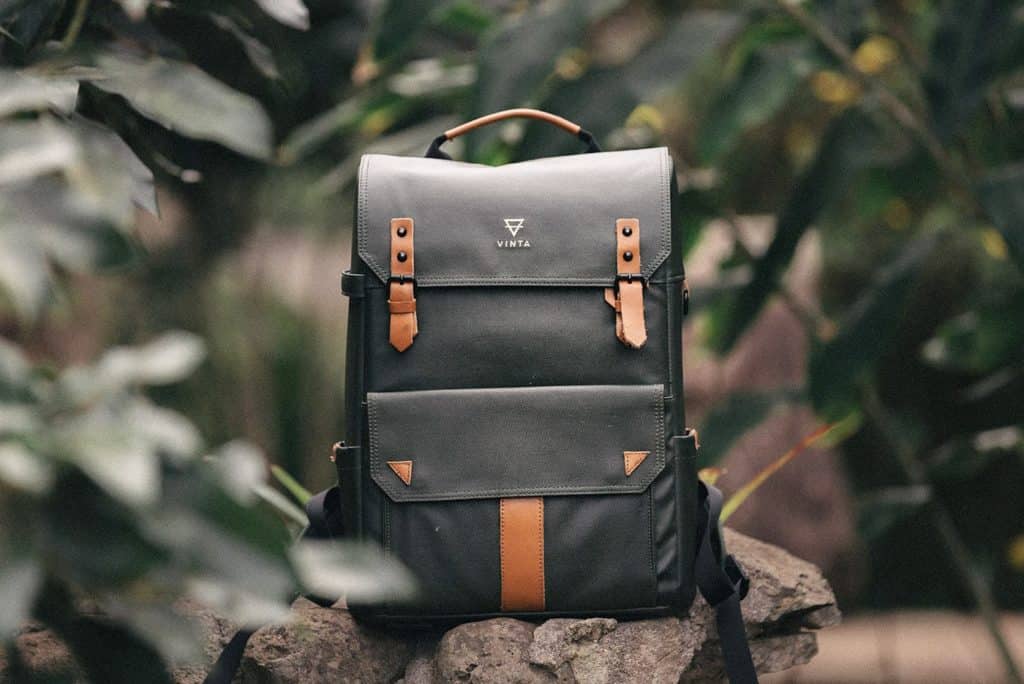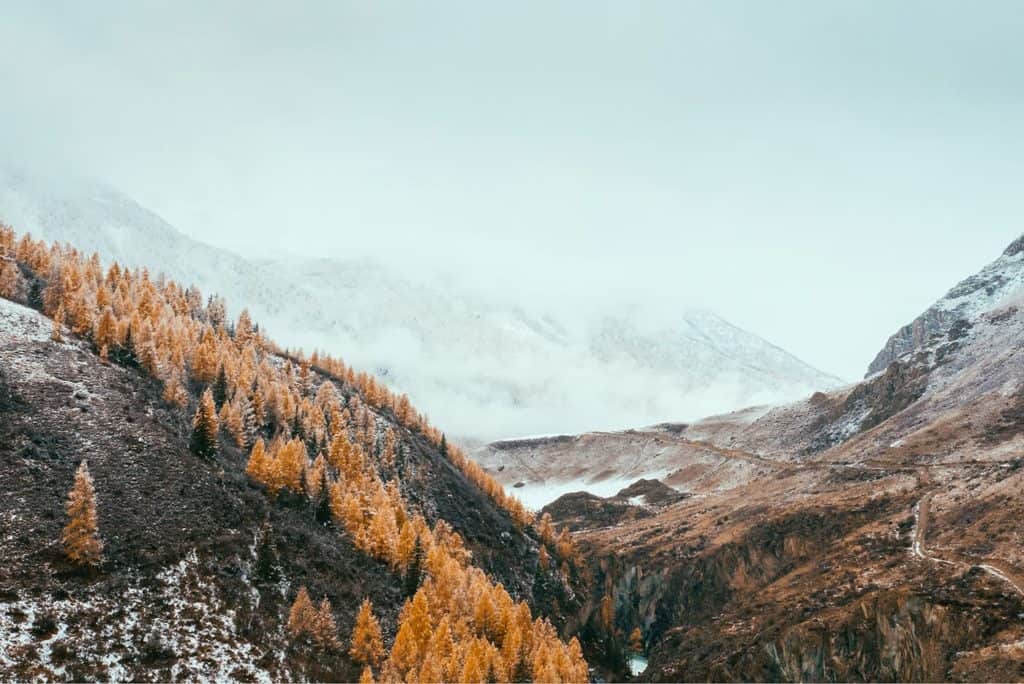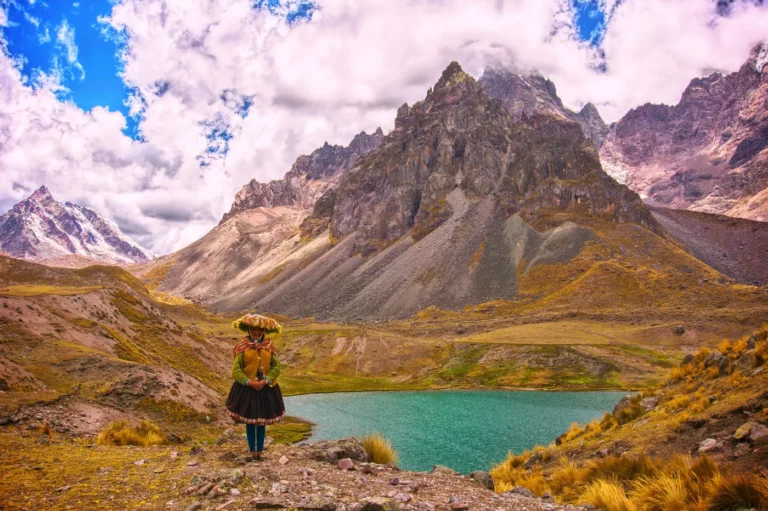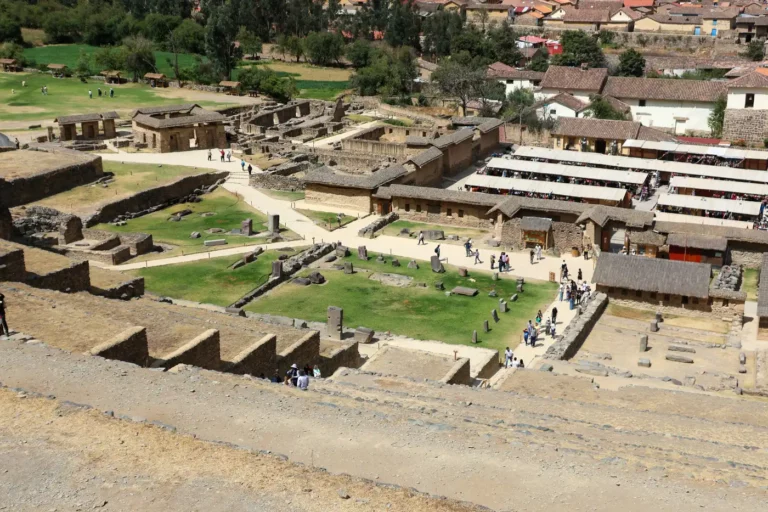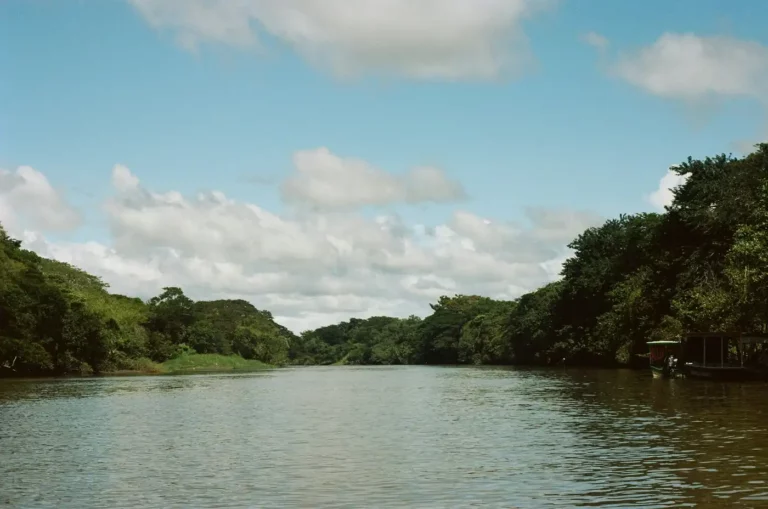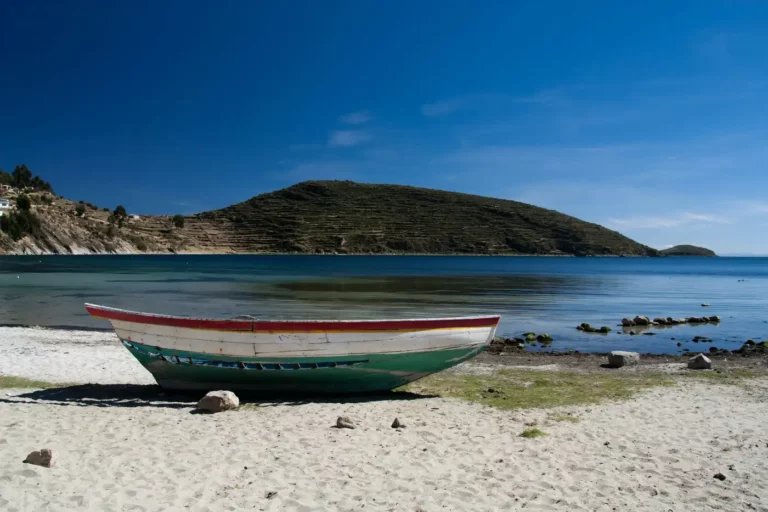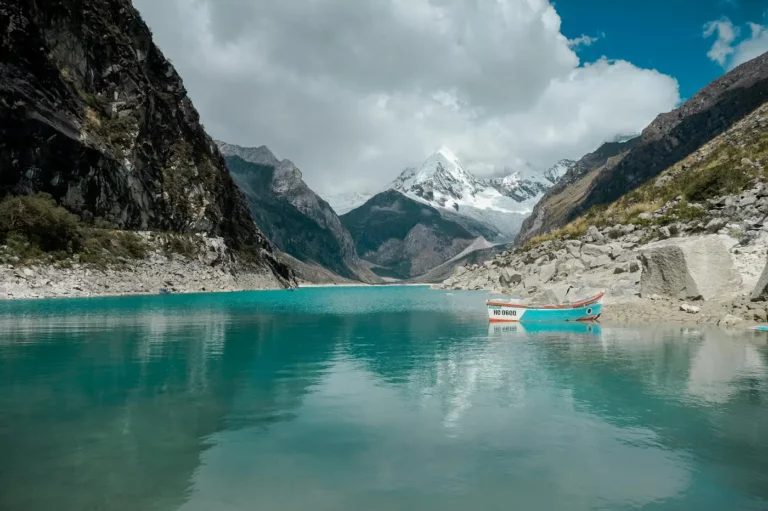overview
In this classic Andean trek, you experience some of the world’s most breathtaking mountain scenery along with some of its finest archeological sites.
On the Salcantay Trek, you discover the Vilcabamba Cordillera, an exhilarating range of steep valleys, lacy waterfalls, and towering granite snowpeaks. Five hundred years ago, the Incas united each valley and pass with a network of exquisitely crafted stone highways. Life in these mountains has changed little: the Quechua-speaking peasants scattered through these high green valleys nurture their herds, till the soil with traditional tools, and make coca leaf offerings to the powerful Apu (mountain spirit) residing in the sacred peak of Nevado Salcantay (6,271m/ 20,600′).
Departing for our trailhead at the town of Mollepata, several hours west of Cuzco, you climb to a spectacular camp at the foot of the massive south face of Salcantay. After crossing the unforgettable Incachiriaska Pass at 4,950 m/16,230 ft, you descend a long valley to join the famous Inca Trail to Machu Picchu. You follow mysterious ancient granite paving stones on a spectacular route high above the Urubamba River, until emerging within sight of Machu Picchu. You have a full day at the legendary Lost City of the Incas to explore every corner of this wonderful site.
IMPORTANT: Since this trek includes time on the Inca Trail to Machu Picchu, permits are required. Permits must be purchased far in advance as they sell out 5-6 months in advance! Please plan accordingly and check with us as soon as possible.
Itinerary
Tour Leadership: We pride ourselves on the quality, experience, and wide-ranging skills of our trekking guides. They are Peruvians, born and raised in the Cuzco highlands, who have combined their love of the mountains of their homeland with years of professional training. They are fluent in English, and bring to their groups a variety of personal interests ranging from birding to astronomy. Most of all, they are caring individuals. They make it their personal goal to see that you have the trip of a lifetime.
Important: at the time we confirm your participation on this trek, we register your complete name and your passport number (as these appear on your trip application) with park authorities on the official trek permit. The trek permit is a legal document with specific restrictions limiting changes. You must bring this same passport with you on the trek. If for whatever reason you cannot bring the passport that is registered on the permit at the time of your original booking, or if you change your passport and cannot bring the original document, or if the information you originally supplied differs from what actually appears on your passport, park authorities may refuse you access to the Inca Trail.
Included: full service trek with all the amenities for which we are famous; excellent English-speaking guide; Thermarest sleeping pad; trail duffel. All meals during the trek.
Not Included: Airfare, airport departure taxes (currently approx. $6 for domestic flights, $31 for international filghts;) Machu Picchu Historic Sanctuary fee (as of Aug 1, 2011, the rate is S/.251 – approx. $96 at current exchange rates.) The park fee is subject to change without prior notice; hotels pre and post trek (we can book hotels for you;) meals in Aguas Calientes and Machu Picchu; gratuities for guides and trekking staff; sleeping bag or other personal equipment (you receive a detailed equipment list and other valuable information in our pre-departure packet;) immunizations, insurance, laundry, telephone charges, other personal items.
2025
Departures May – October Arranged on custom basis, on request
2025 Land Cost
US$1,405 (5-16 passengers)
US$1,521 (3-4 passengers)
US$1,896 (2 passengers)
Inca Trail Permit Fee: $136, prepaid to Andean Treks with final payment
Single Supplement: tent and hotel accommodation: $160
Rental sleeping bag $48
Internal Air: Lima/Cuzco/Lima: $330 – $450 (approximate and subject to change)
The Salcantay Trek is a custom trip, arranged on request. Mandatory trek permits are in limited supply, hence you must commit to your trek date at least 5-6 months in advance.
Weight limitations during the trek: We provide you with a heavy-duty trail duffel to carry your personal belongings during the trek. Due to weight restrictions in effect in the Machu Picchu Historic Sanctuary, we limit the total weight of your duffel. For the first half of the trek, from Mollepata to Pauccarcancha, the maximum duffel weight cannot exceed 13 kg (28 lb) including sleeping bag and Thermarest pad. Prior to commencing the porter-supported trek from Wayllabamba to Machu Picchu, passengers must reduce total packed weight to 10 kg (22 lb). You can send your personal belongings not required for the second half of the trek back to Cuzco with some high altitude trek gear. If your personal gear exceeds the maximum permitted weight, you’ll have to transfer some weight from the duffel to your daypack. Prior to com¬mencing the trek, your guide will review packing list and equipment so that you bring along what you need for the trek.
Student ID cards & discounts: Participants 16 years and older with a valid International Student ID card (ISIC) may be eligible for a reduced rate for their trail ticket. In order to qualify for a student trail ticket, we must receive a digital copy (.JPG) of your ISIC at the time you register for the trek. You must also bring the ID on the trek. Passengers who cannot produce student ID judged acceptable to the Machu Picchu Park authority may be refused access to the trail and thus lose their trek. Students 15 years and younger need no student ID, but must send a .JPG of their passport ID page to receive the student rate.
Looking to extend your trekking adventure? Add our thrilling high altitude Vilcanota Llama Trek, available on selected departure dates.
Please Note: We prepare this itinerary many months in advance of your departure. While we will attempt to follow this itinerary as much as possible, we reserve the right to alter services at any time. Any additional costs due to circumstances beyond operator control, including but not limited to flight cancellations, unusual road or river conditions, political or labor unrest or other circumstances beyond our control are the responsibility of the participant.
PLANNING YOUR TRIP
Climate Cuzco has well-defined seasons. From June to August, while Andean winter days are typically sunny and warm, the temperature can drop to below freezing (27°F/-3°C) at night in our high camps. Rain seldom falls during winter. From January to March, the Andean summer months offer daytime temperatures to 85°F/30°C, milder nights (typically to 45°F/8°C) and plenty of rain. Despite some rain, December and April are among our favorite months for trekking, since the mountains are lush with summer flowers and you enjoy plenty of sunshine. Departures during Andean spring and autumn offer weather patterns intermediate between these seasonal extremes.
Clothing Expect a wide range of tem¬perature and precipitation on your program. In high mountain environments, you must be prepared for inclement weather at any time. Even at mid-day, if clouds obscure the sun, the apparent temperature cools dramatically. By packing a system of thin, independent layers of clothing, you can easily add or remove layers to remain comfortable as conditions change throughout the day.
Most trekkers leave camp in the morning wearing a cold-weather layer over T-shirt and shorts. At the first rest stop, after you have warmed up a bit, remove a layer and continue in hot-weather clothing until the temperature cools off later in the day. At all times, carry rain-gear in your day-pack.
Basic clothing list: underwear, thermal underwear (tops and bottoms), socks, light hiking boots, sneakers for around camp, loose-fitting long pants or wind-pants, shorts, T-shirts, long-sleeved shirt, Polarfleece jacket, full rain gear, sun hat, bathing suit, gloves and ski-type hat.
Other Gear Essential: Day pack, sleeping bag, water bottle, iodine-type water purification pills, flashlight, sunglasses, sunscreen, toilet kit, insect repellent. Optional: pocket knife, sewing kit, camera and film, binoculars, paperback book, snacks and/or energy bars.
Your outfitter provides: a heavy-duty, 4,100-cubic-inch trail duffel, Thermarest sleeping pad, tents and communal camping gear. The guide carries a hand-pump water filter.
Vaccinations While no vaccinations are mandatory for entering Peru, and no official is likely to demand to see proof of your vaccination against any disease, some protection is prudent. Consult your physician or local travelers’ clinic for the latest recommendations. For general travel, the most common recommended vaccina¬tions or boosters are against tetanus, typhoid/diphtheria, Hepatitis A, and polio. The World Health Organization does not recommend vaccination against cho¬lera. If you’re visiting the Amazon before or after your trek, ask about yellow fever and chloroquine-resistant malaria. Some countries (notably Brazil) require travelers to show proof of a valid Yellow fever vaccination when arriving from Peru.
Important Notice for Vegetarians, Passengers with Allergies and Other Restricted Diets
In the cities, you will find sufficient vegetarian choices in most restaurants. We serve a variety of freshly-prepared foods in our camps. While our trek meals are designed for omnivores, we are able to satisfy most restricted-diet passengers. Strict vegetarians will have to bring many food supplements from home, as specialty items are unavailable in South America.
If you have food allergies you must detail these on your trip application when you register for your trek. Review these with our guide and operations staff during the trek orientation meeting.
Our approach in meeting the needs of restricted-diet passengers is the same: while our cooks concentrate on providing the main meal, they can heat and serve food supplied by the passengers that the passengers deem safe.
If you have a restricted diet, please ask for our memo detailing our approach to food service on the trek.
Know What You Are Buying There are many trek outfitters in Cuzco, offering Inca Trail packages in a considerable range in quality, reliability, and price. As one of the pioneers of commercial adventure travel in Peru, we are very proud of our record of environmental and social leadership. We set the standard of quality among full-service outfitters. Best Andes Travel/ITTA has been awarded Best Adventure Travel Agency by the Peruvian Ministry of Tourism every year since 1997. The award recognizes the high standards that our guides, cooks, porters and other employees consistently attain. When purchasing your Inca Trail services from overseas agents, be certain you are buying the services operated by Best Andes Travel. Accept no substitutes!
We receive frequent inquiries from travelers desperately seeking Inca Trail trips at the last minute after the companies with which they originally booked “cancelled” their treks. This appears to be yet another example of lowball trek operators attempting to capture market share without backing it up with reliable trail permit management. Unfortunately, in these last-minute circumstances we can do little since the supply of trail permits is strictly limited. We invest substantial manpower toward ensuring that our rosters and permits are in good standing.
Conditions of Employment for Porters Minimum Age: No porters under the age of 18 should be employed.
Trek Leader Behavior: The local trek leaders, chief porters, and other staff, should not exploit their positions and in particular must not ask for or accept any form of bribes from porters. Any person found to be doing this should be dismissed. Porters are able to report problems in absolute confidence to the Inca Tours & Travel Adventures (ITTA) management. A field supervisor, who reports only to the office, will randomly check on activities in the field.
Wages: All staff will receive a fair wage and payment should not be left solely to the local leader but should be supervised by ITTA. Tips will be distributed openly and fairly. Stoves, fuel, pots and pans for food preparation as well as food will be supplied. Transport to where the trek begins, and from the point it ends to their homes is paid for or provided.
Loads: No one shall ever be asked to carry more than 20 kg of trek load, and no more than 27 kg including their own personal items. Clients will be told the maximum luggage they can take with them which is to be carried by porters is 10 kg.
Sleeping: Sleeping tents will be provided. Porters will not sleep outside.
Medical Care: Staff will have access to first aid equipment sent out on the trek. If a porter becomes ill during the trek he will be paid full wages for the trip and he will be given assistance reaching the health care center. Life insurance with medical care coverage will be provided.
Responsibility on the trek: The local leader will be responsi¬ble for the welfare of his staff.
Tipping: Clients should be given advice on how much to tip and the procedure for tipping.
Availability: These guidelines will be made available to local trek leaders, porters and to clients.
Environmental Policy Machu Picchu Climb supports the efforts of the Machu Picchu Historic Sanctuary Authority (UGM) to protect the environment within the park by measures which include limiting the daily capacity of the route, and enforcing a policy of 100% carry in/carry out. We were the first to introduce a system whereby all the camp waste is hauled out of the park. Our system includes portable chemical (biodegradable) toilets, with no holes in the ground and no solid waste left within the park boundaries.
FAQ: Trail Permits in Machu Picchu Sanctuary Q: Do I need to buy a trail permit to hike on the Inca Trail to Machu Picchu? A: Yes. All who use the hiking trails in the Machu Picchu Historic Sanctuary are required to purchase a trail permit. Companies which claim to offer you a trek that does not require a permit are offering a trek which does not enter the Machu Picchu Sanctuary.
Q: How do I buy the permit? A: As part of confirming you on one of our treks, we purchase permits not only for you but for the porters and other trek crew who haul your gear and look after trek operations. In the following discussion, we use “permit” in both the singular sense (“you need a permit to trek in the park”) and in the collective sense (“we purchase a permit for 8 passengers plus trek crew”). Before we can purchase your permit, we need: your full name as it appears on your valid passport (IMPORTANT: check the passport expiry date!), your passport number, your date of birth, and gender. This information appears in the official trail documents and is checked carefully against your passport when you are on the trail. If the information does not match, you may be refused access to the park and lose your trek.
Q: I need to renew my passport. How can I get a permit without a valid passport? A: We can purchase the permit using your expired passport number. You then must bring both the expired passport and your new passport with you on the trail, and present both documents at the checkpoints. If you have no passport at all, then you cannot join a trek until you obtain a passport. If your name or passport number varies from what you supplied to us for the permit application, then the park authority may deny you access to the trail. Therefore, it is essential that you supply accurate passport data, and bring this passport with you to the trek.
Q: I noticed that I gave you an incorrect passport number when I applied to join the trek. Can you fix that? A: So long as permits are available for your trek date, we can purchase a new permit with the new passport number to allow you to participate in the trek. The cost of the original permit is non-refundable. At the trek orientation you will have to pay for both the old permit and the new permit. If no more permits are available, then park authorities may refuse to grant you access to the Inca Trail if your passport number does not match that listed on the permit.
Q: I lost my passport which I gave you to purchase the permit. I’m applying for a new one. What happens now? A: So long as permits are available for your trek date, we can purchase a new permit with the new passport number to allow you to participate in the trek. The cost of the original permit is non-refundable. At the trek orientation you will have to pay for both the old permit and the new permit. If no more permits are available, then park authorities may refuse to grant you access to the Inca Trail if your passport number does not match that listed on the permit.
Q: What does the individual trail permit cost? A: A four-day trek permit costs 248 New Soles, approximately US$84 at current rate of exchange. While most low-budget treks are offered in this four-day format, we operate a five day/four night trek. This allows our passengers an additional day on the trail and a full tour at Machu Picchu. We have been operating at this pace for 25 years, and it remains the best way to see all that the trail offers. Park permit costs are subject to change without prior notice.
Q: Is it possible to join a trekking group close to the trek departure date? A: For all dates but those very early and very late in the trekking season, the answer is a resounding NO. Trekking permits sell out typically two months or more ahead of the trek date. The park authorities allow only 500 people to enter the park for any given day, including guides, cooks, porters, and paying customers. Each person who enters that day needs to be listed on a permit. From the end of March through the end of October, if you’re not on a roster two months prior to your trek, you’ll likely find that no permits are left. When that happens, you have two options – change your holiday dates, or trek outside the Machu Picchu Historic Sanctuary. For an excellent alternate route, we suggest our Moonstone to Sun Temple Trek.
Q: Do other companies have allocations of permits that I can purchase after your supply is sold out? A: No. The park authority sells the permits on a first-come, first-served basis. The permit must specify for each trekker the full name, nationality, passport number, date of birth, and gender. Permits are not transferable, and the only change allowed on the permit is a full cancellation of one or more passengers. The result is that outfitters can buy permits only for passengers actually on their rosters; and once the 500 permits are issued, no more are available from any source.
Q: What about late cancellations? A: Current regulations do not allow us to replace cancelled passengers with new passengers. Trek permits are non-refundable and non-transferable.
Q: If I give you my deposit now, do you buy my permit immediately? A: Not necessarily immediately, but we customarily purchase the permits within a few days of receiving your deposit.
Q: Can I enter Machu Picchu ruins at night on my trek permit? A: No. Night-time entry to the Machu Picchu ruins is currently prohibited by the INC.
Q: Are there student discounts for the trail permit? A: For students 16 years and older, we must receive a digital version of your International Student Card (ISIC), showing the institution, student status, and date of validity. A .JPG file sent to us as an email attachment is the best format to achieve this. For those who will be younger than 16 years at the time of trekking, send a .JPG of the passport ID page. We submit the documentation when we purchase the permit. If the park authority accepts the documentation, then they will issue the permit at the student rate of 50% of the adult rate. If the park authority rejects the documentation, their decision stands and we purchase the adult-rate ticket. Either way, we charge you the actual amount we pay for the permit. The June 18, 2005 regulation specifies that ONLY an ISIC will be accepted; and that the original ISIC must be brought on the trek. Trekkers on student rate tickets who cannot produce ISIC at the trailhead will be charged the difference between student rate and adult rate tickets.
Q: When do I pay for the trail permit? A: You pay the 4-day trek fee at the trek orientation meeting in Cuzco. We bill you in advance for our trek outfitting services, from Cuzco to Cuzco, except for the local payment of the trail fee.
Q: If I change trek dates can I transfer my permit? A: Both your trail permit and your trek deposit are non-refundable and non-transferable. To join a new trek date, we have to start the permit process all over again.
quick facts
- 6 days hiking/4 nights camping/1 night hotel
- Permit required for Inca Trail portion; book 6 months in advance
- In/Out Cuzco
- Remote hiking beneath majestic Nevado Salcantay (6,271 m/ 20,600′)
- Enjoy unspoiled Inca Trails and tranquil Andean valleys
- Explore the magnificent ridge-top city of Machu Picchu

